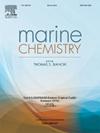Submarine groundwater discharge and gas hydrate dissociation fuel organic matter formation in Arctic fjord sediments
IF 2.5
3区 地球科学
Q2 CHEMISTRY, MULTIDISCIPLINARY
引用次数: 0
Abstract
Arctic fjord sediments store significant amounts of organic matter (OM), contributing to the global carbon cycle, but are increasingly influenced by climate change. This study investigates OM distribution and sources in sediments from 24 stations across three West Spitsbergen fjords (Hornsund, Isfjord, and Kongsfjord-Krossfjord), focusing on relationships with porewater chloride concentrations and stable water isotopes. Freshening of porewater indicated by low chlorinity was detected in Isfjord and Hornsund. In Hornsund and Tempelfjord (Isfjord), water isotope signatures point to a meteoric origin, likely via submarine groundwater discharge (SGD). In contrast, Ekmanfjord (Isfjord) shows isotopic evidence of gas hydrate dissociation as the freshening source. Both Isfjord sites contain OM with low δ13Corg < –26.8 ‰) and δ15Ntot (< 3.1 ‰) values, which are inconsistent with known OM sources in Svalbard fjords. We propose that carbon released from SGD and gas hydrate dissociation, along with methane oxidation and nitrogen assimilation by methanotrophic microbes, contribute to OM formation. These findings suggest that Arctic fjord sediments may help mitigate climate change by supporting microbial processes that consume methane, a potent greenhouse gas.
海底地下水排放和天然气水合物解离为北极峡湾沉积物有机质形成提供燃料
北极峡湾沉积物储存了大量的有机物(OM),为全球碳循环做出了贡献,但受到气候变化的影响越来越大。本研究调查了西斯皮次卑尔根三个峡湾(Hornsund、Isfjord和kongsjord - krossfjord) 24个站点沉积物中OM的分布和来源,重点研究了孔隙水氯浓度和稳定水同位素的关系。在Isfjord和Hornsund检测到低氯含量的孔隙水变新鲜。在霍恩松德和坦普尔峡湾(Isfjord),水的同位素特征指向大气起源,可能是通过海底地下水排放(SGD)。相比之下,埃克曼峡湾(Isfjord)显示了天然气水合物解离作为新鲜来源的同位素证据。两个Isfjord遗址均含有低δ13Corg (< -26.8‰)和δ15Ntot (< 3.1‰)值的OM,这与斯瓦尔巴峡湾已知的OM来源不一致。研究人员认为,甲烷发酵过程中释放的碳和天然气水合物的解离,以及甲烷氧化和甲烷营养微生物对氮的同化,都有助于有机质的形成。这些发现表明,北极峡湾沉积物可能通过支持消耗甲烷(一种强效温室气体)的微生物过程来帮助减缓气候变化。
本文章由计算机程序翻译,如有差异,请以英文原文为准。
求助全文
约1分钟内获得全文
求助全文
来源期刊

Marine Chemistry
化学-海洋学
CiteScore
6.00
自引率
3.30%
发文量
70
审稿时长
4.5 months
期刊介绍:
Marine Chemistry is an international medium for the publication of original studies and occasional reviews in the field of chemistry in the marine environment, with emphasis on the dynamic approach. The journal endeavours to cover all aspects, from chemical processes to theoretical and experimental work, and, by providing a central channel of communication, to speed the flow of information in this relatively new and rapidly expanding discipline.
 求助内容:
求助内容: 应助结果提醒方式:
应助结果提醒方式:


